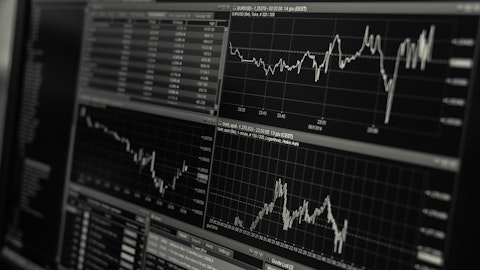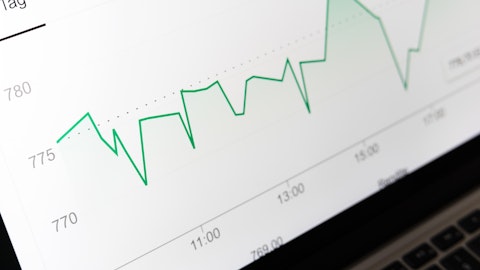Barings BDC, Inc. (NYSE:BBDC) Q4 2023 Earnings Call Transcript February 23, 2024
Barings BDC, Inc. isn’t one of the 30 most popular stocks among hedge funds at the end of the third quarter (see the details here).
Operator: At this time, I would like to welcome everyone to the Barings BDC, Inc. Conference Call for the Quarter-Ended and Year-Ended December 31st, 2023. All participants are on a listen-only mode. A question-and-answer session will follow the company’s formal remarks. [Operator Instructions] Today’s call is being recorded, and a replay will be available approximately 2 hours after the conclusion of the call on the company’s website at www.baringsbdc.com under the Investor Relations section. At this time, I will turn the call over to Joe Mazzoli, Head of Investor Relations for Barings BDC.
Joe Mazzoli: Please note, that this call may contain forward-looking statements that include statements regarding the company’s goals, beliefs, strategies, future operating results and cash flows. Although the company believes these statements are reasonable, actual results could differ materially from these projected and forward-looking statements. These statements are based on various underlying assumptions and are subject to numerous uncertainties and risks, including those disclosed under the sections titled Risk Factors and Forward-Looking Statements in the company’s annual report on Form 10-K for the fiscal year ended December 31st, 2023, as filed with the Securities and Exchange Commission. Barings BDC undertakes no obligation to update or revise any forward-looking statements unless required by law. I’ll now turn the call over to Eric Lloyd, Chief Executive Officer of Barings BDC.
Eric Lloyd: Thanks, Joe and good morning, everyone. We appreciate you joining us for today’s call. Please note that throughout today’s call, we’ll be referring to our fourth quarter 2023 earnings presentation that was posted on the Investor Relations section of our website. On the call today, I’m joined by Barings’ Co-Head of Global Private Finance and President of Barings BDC, Ian Fowler; the BDC’s Chief Financial Officer, Elizabeth Murray; and BDC’s Co-Portfolio Managers, Bryan High; and Matt Freund. We will dive into some quarterly results momentarily. But first, I would like to comment on some of the successes we experienced during the entirety of 2023. Investing in the illiquid assets is often poorly suited for short-term investors.
Measuring performance in a single quarter really gives investors the appropriate lens to measure a manager’s performance. Net investment income, total dividends paid to shareholders and NAV for BBDC, all increased during 2023. While these items are important, we are equally focused on some developments not immediately captured in these metrics. During 2023, we continued executing on our commitment to rotate out of non-core assets including three legacy MVC Capital positions and more than $25 million of investments to legacy Sierra Income positions. We again demonstrated our best-in-class alignment with shareholders, repurchasing more than 1.8 million shares for nearly $15 million. The number of issuers on non-accrual declined from 7% at December 2022 to 4% as of December 2023.
We manage our portfolio based on operational metrics that drive stability of returns, and we expect that in the coming quarters, the commitment to our core strategies will continue to deliver for shareholders. Successful financial results such as those measured by NAV and distributions over time are the outputs, not the inputs to a successful asset manager. BBDC exhibited stability and strong operating results during the quarter ended December 31st. Our focus on the top of the capital structure, investments in sponsor-backed issuers is serving investors well in these uncertain times. Our portfolio is predominantly sponsor-backed and is complemented by a selection of non-sponsored and platform investments. Our portfolio strategy is outlined in greater detail on Slide 5.
This strategy serves as our guiding light as we continue to successfully invest throughout the market and deliver compelling returns to our shareholders. Net asset value per share was $11.28 compared to the prior quarter of $11.25 and $11.05 at December 2022, reflecting a year-over-year increase of 2.1%. Net investment income for the quarter was $0.31, unchanged from prior quarter. Our performance is the result of our focus on the top of the capital structure and within more defensive industries. We believe BBDC remains well positioned for any further volatility and uncertainty in the market going forward. Investment activity during the quarter reflected a modest degree of net repayments, driven by light transaction activity during the quarter and balancing the use of our share repurchase program with other opportunities.
As our shareholders know, we are actively working to maximize the value in the legacy holdings acquired from MVC Capital and Sierra Income and rotate them into compelling Barings-originated positions. Non-Barings-originated assets now only amount to 11% of the portfolio at fair value. That’s down from 24% at the beginning of 2022 and potential losses from these assets are protected by the credit support agreements limiting downside risk for BBDC investors. Our investment portfolio continued to perform well in the third quarter. Including the acquired Sierra and MVC assets, our total non-accruals are 2.5% of the portfolio on a cost basis and 1.5% on a fair value basis, with three assets being removed from non-accrual during the quarter. With the exception of two investments, all of our non-accrual assets were from acquired portfolios and therefore, are covered by our credit support agreements.
Subsequent to year-end, we removed our investment in Core Scientific, Inc. from non-accrual status in connection with its January 2024 exit from Chapter 11 bankruptcy and our receipt of shares of its common stock in exchange for the debt investments that we previously held in part of the bankruptcy proceedings. On a pro forma basis, removing Core Scientific that takes down accruals down to 0.6% on a fair value basis and 1.3% on a cost basis. Turning to the earnings tower of the portfolio. The increase in base rates has largely been reflected within the portfolio with weighted average yields on floating rate investments stabilizing at 11.2%, substantially comparable to the prior quarter’s figures. We remain conservative on our base dividend policy and our Board declared a fourth quarter dividend of $0.26 per share, consistent with the prior quarter.
On an annualized basis, the dividend levels — level equates to a 9.2% yield on our net asset value of $11.28. Now, I’ll turn the call over to Ian.
Ian Fowler: Thanks, Eric and good morning. Recall that BBDC is managed by Barings LLC, a credit-focused asset manager with more than $300 billion of assets under management. The bulk of the portfolio is sourced from the Global Private Finance team. An organization with more than 100 investment professionals located around the globe, providing financing solutions to preeminent middle market companies sponsored by private equity firms. BBDC’s portfolio decreased by $51 million on a net basis in the quarter, with gross fundings of $192 million, offset by $244 million of repayments and sales which included approximately $50 million of sales to our Jocassee joint venture. Activity during the fourth quarter continued to be tempered as private equity buyers take a pause in the rising rate environment which we believe has a meaningful impact on enterprise valuations.
Based on recent conversations, investment bankers who serve as the tip of the spear have reiterated their expectation that LBO activity is expected to meaningfully increase in the quarters to come. With that said, the messaging has been consistent for the past 12 months as more and more opportunities are being added to the backlog, but the dam has not yet broken. Consistent with the prior two quarters, we have seen an increase in the number of early-stage opportunities within the platform, but unfortunately, conversion rates to close deals are trending towards historic lows. Sponsors continue to execute on add-ons for companies already within their portfolios, which makes sense as add-on multiples are below original platform purchase price in effect, enabling sponsors to reduce their cost bases and hedge against any compression and exit multiples.

Investors in Barings BDC benefit by having a seasoned portfolio that provides opportunities to deploy capital in two issuers, we already know well. Refinancing activity has started to increase as performing issuers have plentiful access to capital without the need to sell. There is a logical reason to believe transaction volumes improve in the months to come, namely a record backlog of sell-side mandates among the investment banking community and a need for private equity managers to show distributions to their LPs. Counter to those facts is a high level of uncertainty created by two arm conflicts, persistently high inflation, rapid increase in interest rates in the forthcoming political cycle. When opportunities ultimately do convert into an increase in closed transactions, we will continue to use our disciplined underwriting strategy to invest capital in the most compelling opportunities.
Turning to our current portfolio. 74% consists of secured investments, with approximately 67% of investments constituting first-lien securities. Interest coverage within the portfolio stood at 2.2 times, modest decline from 2.3 times a quarter earlier. We are forecasting that a steady-state weighted average interest coverage for the portfolio will ultimately fall between 2 and 2.25 times as the full impact of higher rates is reflected in issuer’s financials and performance. Our avoidance of various industries prone to economic volatility, oil and gas, restaurants, retail, metals, among them, has proven to be a sound strategy against a backdrop of less economic predictability. One of the benefits to a predominantly sponsor-backed strategy has proven out over the past several quarters.
Combined with what we believe were reasonable going in leverage multiples, the median gross margin in the North American Global Private Finance portfolio, a portfolio similar to BBDC stood at 49%, up from 45%, one year earlier and gives us confidence that our issuers are successfully pushing through price increases to combat inflationary pressures in their businesses. Adjusted EBITDA margins for the same sample set were 22%, up from 21% in prior year’s period, believed to be a reflection of the fact that wage gains have consumed some degree of gross margin expansion previously noted. While not perfectly comparable metric period-to-period as the volume of transaction activity in the past five quarters will skew these metrics somewhat, we believe we have reason to feel comfortable with the performance of the portfolio.
The portfolio composition remains highly diversified with the top 10 issuers accounting for 20.1% of fair market value. Recall that the two top positions within the portfolio, Eclipse Business Capital and Rocade Holdings, our platform investments originating middle-market loans. These positions have a number of underlying issuers. Assets included in the other classification include structured positions and certain acquired positions that will not be originated on a new basis going forward. As Eric highlighted, we anticipate rotating of these positions as market conditions allow in the quarters to come. Risk ratings exhibited minimal movement during the quarter as issuers exhibiting the most stress classified as risk ratings 4 and 5 were 7% on a combined basis quarter-over-quarter.
We anticipate this figure to decline when rolling to the first quarter in light of public developments with one of our issuers, Core Scientific, as Eric mentioned. Encouragingly, we also experienced some positive movement at certain issuers performing consistent with expectations at underwriting have outperformed during the fourth quarter. We remain confident in the credit quality of the underlying portfolio, the uncorrelated nature and associated value of investments in Eclipse and Rocade should bolster the portfolio in the event the economy enters into a long expected recession. BBDC is committed to delivering an attractive risk-adjusted return to shareholders over a long time horizon. We are investors of credit and middle-market companies.
Our global reach and significant scale across asset classes gives BBDC a unique ability to select risk and return compared to other managers, but our core middle market credit is what we do. I’ll now turn the call over to Elizabeth.
Elizabeth Murray: Thanks, Ian. On Slide 15, you can see the full bridge of the NAV per share movement in the fourth quarter. NAV per share was $11.28 as of December 31st, which is an increase of 0.3% over the prior quarter and more than a 2% increase versus December 31st, 2022. Our net investment income exceeded the $0.26 per share dividend by 19% and share repurchases added another $0.01 per share. This was partially offset by net unrealized depreciation and realized gains of $0.03 per share. The valuation of the credit support agreements increased by approximately $3.6 million, which is driven by unrealized depreciation in the underlying Sierra portfolio and a reduction in the applicable discount rates during the quarter. Our net investment income was $0.31 per share for the quarter or $0.33 per share on a pre-tax basis, compared to $0.31 per share in the prior quarter.
This is driven by continued benefits from higher base rates and dividend income from our platform investments and joint ventures. Our net leverage ratio, which is defined as regulatory leverage net of cash and net unsettled transactions was 1.15 times at quarter end, down modestly from 1.18 times in the quarter ended September 30th and currently sits within our long-term target of 0.9 to 1.25 times. Our funding mix remains highly defensible, both in terms of seniority and asset class, including the significant level of support provided by the unsecured debt and our capital structure. At December 31st, our unsecured debt accounted for $725 million of our fundings and equated to 50% of our outstanding balances. During the first quarter of 2024, Barings BDC issued a new $300 million senior unsecured note to enhance the flexibility of our capital structure.
The net issuance was significantly oversubscribed, and we are pleased to position BBDC with significant operating flexibility in the quarters to come. Pro forma for the note issuance, BBDC now has more than $1 billion of unsecured debt liabilities accounting for more than 70% of our debt outstanding. We continue to maintain significant flexibility in our capital structure with the next bond maturity in the second half of 2025 and pro forma for the $300 million notes issued, we have expanded our ladder of maturities out to 2029. Barings BDC currently has $241 million of unfunded commitments to our portfolio companies as well as $65 million of outstanding commitments to our joint ventures. We have available cushion against our leverage limit to meet the entirety of these commitments have called upon.
Eric noted earlier that we have actively been utilizing our share repurchase plan during 2023. The fourth quarter was no exception as we repurchased nearly 450,000 shares during the period and over 1.8 million shares in total for 2023. In addition, the Board authorized a new $30 million share repurchase plan for 2024. Our focus on share repurchases is one example of BBDC’s thoughtful approach to aligning our interest to shareholders. As mentioned earlier, the Board declared a first quarter dividend of $0.26 per share, a 9.2% distribution on net asset value. We consistently evaluate our dividend policy in the same manner we manage our broader business, driven by stability. Since Barings became the adviser in 2018, we have a track record of increasing or maintaining a stable dividend.
We believe we can maintain a stable dividend even in a normalized rate environment, and we expect that our platform investments, Eclipse and Rocade as well as our Jocassee joint venture will continue to generate significant dividend income. These investments help highlight the importance of less correlated assets and the benefit of a diverse portfolio. I’ll wrap up our prepared remarks with a note on our investment pipelines. Thus far, in Q1, we have made $42 million of new commitments, of which $35 million have closed and funded. With that, operator, we’ll open the line for questions.
See also 25 Largest Economies in the World by 2100 and 12 Best Wind Power and Solar Stocks To Buy.
Q&A Session
Follow Barings Bdc Inc. (NYSE:BBDC)
Follow Barings Bdc Inc. (NYSE:BBDC)
Operator: Thank you. The floor is now open for questions. [Operator Instructions] The first question is coming from Finian O’Shea of Wells Fargo Securities. Please go ahead.
Finian O’Shea: Hey, everyone, good morning. Question for Ian. I appreciated your color on transaction volumes being slow to transpire. Question is, if that continues to stall, do you think we’re looking at sort of a triage, a great triage from private equity? And if so, if you then have to take keys for companies, can you talk about how well you are positioned for that? Maybe how many sets of keys you could practically take on at the platform? Thank you.
Ian Fowler: Good morning, Fin. Yeah, so like I said, we had hoped that things were going to pick up that’s investment bankers are pretty good about talking their book. And that really hasn’t happened thus far this year. Now, what I will say is, there’s a lot of pressure for this market to open up. So I would — unless there’s some kind of black swan event, I would be really surprised if we have a low anemic year again of M&A activity. I mean, we’re looking at — base rates have plateaued. The Fed has telegraphed that they’re likely coming down. That’s obviously a positive given the valuation gaps that exists in the market between buyers and sellers. We have the election, so we need to get through that political uncertainty.
I think most importantly, though, and you raised private equity and obviously, we’re focused on private equity. I think one of the biggest triggers is the pressure on private equity and the fact that a lot of LPs now are tying LP commitments to realizations. And so quite frankly, I think based on what we’ve seen — the data we’ve seen, the valuation gap isn’t huge, but it’s not what private equity firms were expecting. And I think, ultimately, they’re going to be forced to realize some companies, maybe lose a turn or two on the exit multiple, but still generate historically decent returns. So I think volume is going to pick up in ‘24 as we get later in the year and ‘25. If rates come down materially, it could be a watershed environment.
Of course, if that doesn’t happen, we’re still in this period of and for those platforms that have mature portfolios. There’s still that incentive to do add-on acquisitions and create value. And that allows us to put more money to work. 70% of our origination last year came from our portfolio. It also means low runoff. And so that creates AUM stability. So that’s positive. If this really gets stretched out, I think this is where you’re going with your question, then we’re going to have to figure out how to deal with some of these companies if they’re not performing, we’re, of course, prepared. It’s something we don’t want to do to take the keys. I can tell you that it’s not in the BBDC, but we had one company during COVID that we had to take the keys in North America and the company is up for sale.
So we’ve got experience doing that. We also have a very large team, over 100 people globally. So I think we’re pretty well prepared if we have to go down that road, but that’s kind of the — that’s something you don’t really want to go to unless you have to.
Eric Lloyd: And I’ll just build on that. The $100 million that Ian referenced, that’s just on the — that’s on the investment side in the direct lending area. In addition to that, we have a deep legal team internally that has strong experience working through situations like this. We have a special situation now called Capital Solutions team, has a lot of experience working through things like this. So at a firm level, we kind of bring all resources to bear and all expertise to bear to make sure we have the best outcome for our investors in those type of challenging situations.
Finian O’Shea: Very helpful. Thank you. This is a follow-up on the recent bond issuance this quarter, January or February. Understanding the benefit of unsecured, it’s also a more expensive market, and it looks like you already had adequate unsecured debt for your ratings and so forth. So seeing if you could provide color on the thinking there and the timing and why more unsecured? Thank you.
Elizabeth Murray: Yes. Thanks, Fin. When we originally went to market in 2021, we had messaged at that point that we would be a serial issuer. And so, of course, the markets have been closed for the past couple of years, and they recently opened up with several other BDCs in the market and looking at our maturity ladder and also our mix between secured and unsecured, we felt like it was an appropriate time and this again extends our maturity ladder. As soon as the $300 million came in, we used that to repay some of our credit facility. So I think long-term, this really sets us up for success. I’ll also say, Fin, that we did swap the interest rate on this. So we have a swap in place.
Eric Lloyd: Thanks so much.
Operator: Thank you. The next question is coming from Kyle Joseph of Jefferies. Please go ahead.
Kyle Joseph: Thanks guys. Good morning. Thanks for taking my questions. I think first one for Ian. Just kind of want to get your take on how the competitive environment has evolved over the last few years with kind of the slower deal flow, as you mentioned, but also recognizing BDCs at least publicly have been resilient to higher rates in inflation. But give us a sense for what spreads have been doing and what if the steel environment were to come to fruition, expectations for spreads in that environment?
Ian Fowler: Yeah. Great question, Kyle. Good morning. So, like I said, obviously, the economy is slow. M&A activity down in our space in the last few years. There’s more platforms that have been created. A lot of capital has been raised, but not deployed, just given the conditions in the M&A market. So there’s a lot of pressure coming from investors for managers to deploy capital. Again, I think if you’ve got a portfolio, you’re in a sweet spot because at least you’re putting capital to work in companies you know well and helping those companies become bigger, better, stronger, more diversified credits. So that’s sort of a safer bet. And if you’ve got to play the new M&A market, which not only being low in volume, the quality of deals has been very inconsistent.





